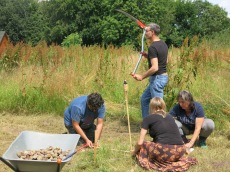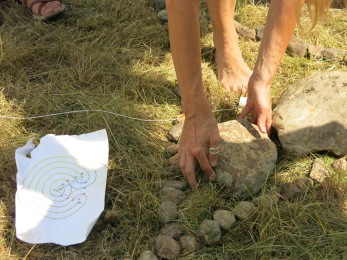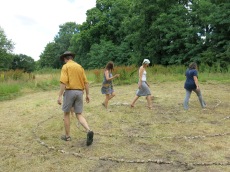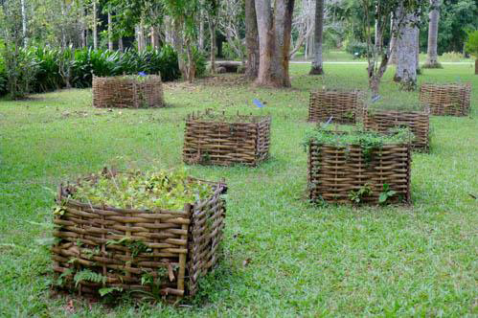Our local beekeeper asked us to put some of his hives on the property. Here, he said they would be safe and close to the canola fields. In the past 4 weeks, we were privileged to witness an interesting bee phenomenon: all of a sudden, a loud buzzing noise fills the air, you can´t miss it – the air is full of buzz and bees. 
Then, 10 minutes later, they find a place to settle, on a bush or a tree. They form a large clump hanging down from a tree or bush.
Swarming, explains our beekeeper, is the process by which a new honey bee colony is formed when the queen bee leaves the colony with a large group of worker bees. In the prime swarm, about 60% of the worker bees leave the original hive location with the old queen.
Our beekeeper had to come and collect as many as 7 swarms. He comes with his gear and scoops them into an empty box, hoping he gets the queen. As the worker bees follow her, he soon has a new hive, with about 20- 25’000 bees.
Bees: Distributed Decision Making Process
I find it extremely interesting how they communicate and find a new place for their hives in the wild: First, the worker bees follow the pheromone track of the old queen bee. Once they settle on a tree, the scouting bees swarm out to look for a new place to go. Then, scouting bees swarm out again to look for new potential locations. Wikipedia explains about nest place selection: “On returning to the cluster, they use their famous waggle dance to indicate direction, distance, and quality to others in the swarm. The more excited she is about her findings the more excitedly she dances. If she can convince other scouts to check out the location she found, they may take off, check out the proposed site, and may choose to promote the site further upon their return. Several different sites may be promoted by different scouts at first. After several hours and sometimes days, slowly a favorite location emerges from this decision making process. In order for a decision to be made in a relatively short amount of time (the swarm can only survive for about three days on the honey on which they gorged themselves before leaving the hive), a decision will often be made when somewhere around 80% of the scouts have agreed upon a single location, and/or when there is a quorum of 20-30 scouts present at a potential nest site. When that happens, the whole cluster takes off and flies to it. A swarm may fly a kilometer or more to the scouted location, with the scouts guiding the rest of the bees by quickly flying overhead in the proper direction. This collective decision making process is remarkably successful in identifying the most suitable new nest site and keeping the swarm intact. A good nest site has to be large enough to accommodate the swarm (minimum 15 liters in volume, preferably ~40 liters), has to be well protected from the elements, have a small entrance (approximately 12.5 cm squared) located at the bottom of the cavity, receive a certain amount of warmth from the sun and not be infested with ants. In addition to these criteria, nest sites with abandoned honeycombs are preferred, as this allows the bees to better conserve their resources”
This is how they ended up in a hollow in our old lime tree. I was wondering how they knew…
At the end, about 4 swarms are rewilded, the beekeeper has 7 new ones and we ended up with 10 liters of prime canola honey from the fields next door. 














 Playing with complex adaptive and complex responsive systems, we gained a new understanding of the nature of emergent processes. We explored new guidance and design principles for organzational life. We looked at how to negotiate organizational and personal intentions, value streams and identities, how to solve the tension between our uniqueness, asymmetrical needs and the distribution of energy, decision and power in a group. We looked at the design of the architecture of the organizational space– one that allows for the release of built up complexity, for emergent behavior and novelty to arise. We experimented with the four languages of change, that are at the core of Bonnie’s OPO, the Open Participatory Organization: “I call this new design The Open Participatory Organization, or OPO for short. The OPO is a fully integrated design. It is an open architecture that is supported by a participatory communications platform and is backed-up by a governance that evolves as the organization evolves” from Bonnie’s
Playing with complex adaptive and complex responsive systems, we gained a new understanding of the nature of emergent processes. We explored new guidance and design principles for organzational life. We looked at how to negotiate organizational and personal intentions, value streams and identities, how to solve the tension between our uniqueness, asymmetrical needs and the distribution of energy, decision and power in a group. We looked at the design of the architecture of the organizational space– one that allows for the release of built up complexity, for emergent behavior and novelty to arise. We experimented with the four languages of change, that are at the core of Bonnie’s OPO, the Open Participatory Organization: “I call this new design The Open Participatory Organization, or OPO for short. The OPO is a fully integrated design. It is an open architecture that is supported by a participatory communications platform and is backed-up by a governance that evolves as the organization evolves” from Bonnie’s  Picture: Bonnitta Roy,
Picture: Bonnitta Roy, 










































![DSCN3477[1] - Kopie DSCN3477[1] - Kopie](https://schmagerow.files.wordpress.com/2016/05/dscn34771-kopie.jpg?w=348&resize=348%2C261&h=261#038;h=261)

































































































































